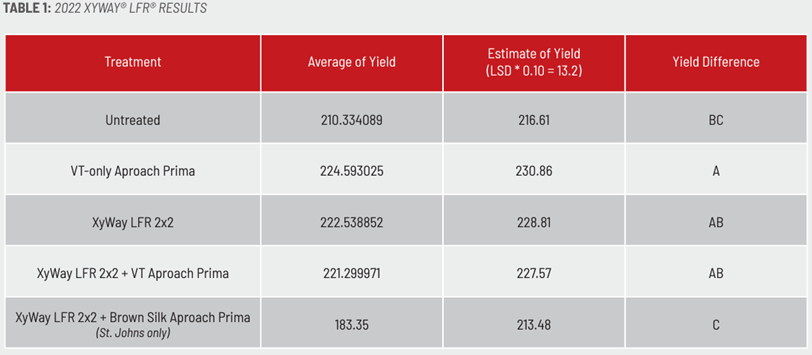2023 PAR (Product & Agronomy Research) Report: Soil Applied Fungicide For Corn
BY Dairyland Seed Agronomy Team
XyWay® LFR® Liquid Fertilizer Ready is a group 3 triazole fungicide that is applied in a 2x2 application at planting on corn.
XyWay® LFR® is used to control northern corn leaf blight and gray leaf spot up to reproductive stages in corn. XyWay® LFR® promotes early season plant health, and we will look at possible efficacy for tar spot suppression until foliar applications can be made during reproductive development stages of corn.
We will monitor disease progression in all three treatments to rate the control of XyWay® LFR® alone and in conjunction with foliar fungicide applications.
TREATMENT
- Untreated
- XyWay® LFR®
- XyWay® LFR® + VT foliar application
- VT application (St. Johns only)
Wabash, IN Hybrids DS-4219AM™ and DS-4833AM™
- XyWay® LFR® applied 15.2 ounces per acre in 2x2 at planting (Wabash)
- Veltyma® applied at VT at 7 ounces per acre (Wabash)
St Johns, MI Hybrids DS- 3601AM™ and DS-4510Q™
- XyWay® LFR® applied 15.2 ounces per acre with Conceal (St Johns)
- Aproach® Prima applied at VT 6.8 ounce per acre (St Johns)
RESULTS



CONCLUSION
In 2022, there was not much disease pressure in either the Wabash, IN or St. Johns, MI sites.
This study showed that in 2022, a VT application provided the most return in both locations. The VT application yielded the most return at the St. Johns location in 2023, and the XyWay® LFR® application yielded the most at the Wabash site in 2023.
In Wabash, the combination of a VT application and XyWay® LFR® increased yield by three bushels per acre, where the XyWay® LFR® alone increased yield by five bushels per acre over the check.
Maintaining plant health through the season is important to insuring maximum yield potential. XyWay® LFR® application timing is convenient if growers are already applying products off the row in a 2x2 or other similar system. However, if a yield limiting disease does not impact the crop during the residual window on XyWay® LFR®, which is about tassel time, then a later infection can decrease yield.
Tar spot is a concern for growers in both Indiana and Michigan. Ensuring plant health through the season is important, but fungicide applications, either soil or foliar, applied will vary depending on management systems, location and hybrids used.

Brian Weller
Western Region
507.456.3034

Rod Moran
Western Region
507.456.3034

Dan Ritter
Central Region
219.863.0583

Branden Furseth
Northern Region
608.513.4265

Mark Gibson
Eastern Region
260.330.8968

Amanda Goffnett
Eastern Region
989.400.3793

Ryan Mueller
Eastern Region
989.400.3793
